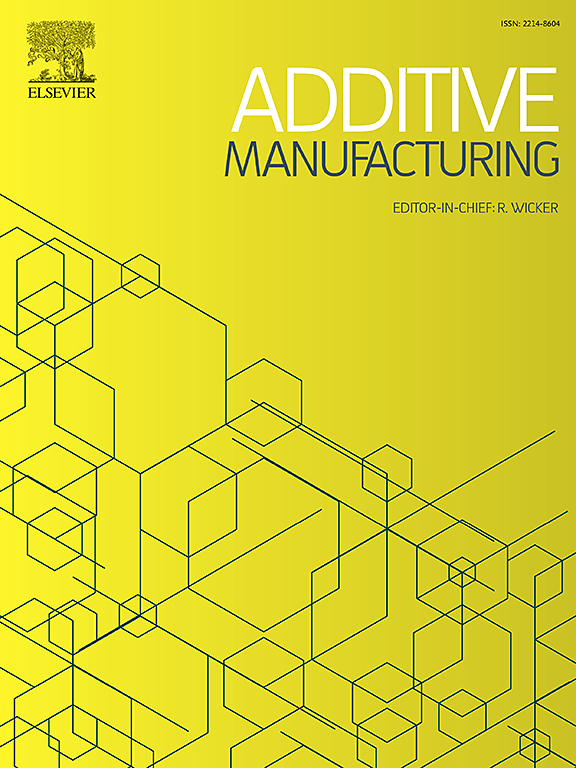不同成分梯度设计下Ti6Al4V/TiC功能梯度材料的非均匀变形响应
IF 11.1
1区 工程技术
Q1 ENGINEERING, MANUFACTURING
引用次数: 0
摘要
金属/陶瓷功能梯度材料(fgm)由于其在保持优异机械强度的同时提高耐热性的能力而引起了相当大的关注。然而,陶瓷颗粒的非均匀空间梯度分布使得fgm在静载荷作用下的变形和断裂行为非常复杂。优化成分梯度设计以提高机械性能和断裂韧性,同时保持耐热性一直是一个长期存在的难题。设计了凸函数模式、线性模式和凹函数模式三种陶瓷成分梯度转变方法,并采用激光直接能量沉积(LDED)制备了Ti6Al4V/TiC fgm, TiC质量分数从0 %逐渐变化到30 %。为了揭示不同成分梯度模式下的非均匀变形响应和断裂机理,对沉积态Ti6Al4V/TiC fgm的显微组织表征、原位DIC拉伸测量和断裂形貌进行了综合分析。结果表明,在纵向拉伸过程中,应变沿中轴线呈波浪状非均匀梯度分布,而塑性变形能力较好的低梯度层通过局部化带缓解了高梯度层的应力集中。与凸函数过渡模式相比,凹函数过渡模式抗拉强度沿z方向明显提高201 MPa,伸长率提高1.11 %,体现了强度和延性的协同提高。这是由于在更多的区域增加了塑性变形的发生,从而产生了更强的梯度协同强化效果。同时,通过积分变换和对偶积分方程求解,得到了不同梯度过渡模式下裂纹尖端的应力强度因子,进一步从理论上验证了上述结论。断裂往往发生在高梯度陶瓷区,主要是由于未熔化颗粒断裂导致过早失效。这项工作强调了非线性成分设计策略在金属/陶瓷功能梯度材料开发中的重要性。本文章由计算机程序翻译,如有差异,请以英文原文为准。
Non-uniform deformation response of Ti6Al4V/TiC functionally graded material under different composition gradient designs by direct energy deposition
Metal/ceramic functionally graded materials (FGMs) have garnered considerable attention due to their capability to improve heat resistance while maintaining excellent mechanical strength. However, the non-uniform spatial gradient distribution of ceramic particles makes the deformation and fracture behavior of FGMs very complicated during static loading. Optimizing the composition gradient designs to enhance mechanical properties and fracture toughness while maintaining heat resistance has been a longstanding puzzle. Herein, three ceramic composition gradient transition methods including convex function mode, linear mode and concave function mode were designed, and Ti6Al4V/TiC FGMs were fabricated by laser direct energy deposition (LDED), with TiC mass fraction gradually changing from 0 % to 30 %. To reveal the non-uniform deformation response and fracture mechanism under different composition gradient modes, comprehensive analyses of microstructure characterization, in-situ DIC tensile measurement and fracture morphology of as-deposition Ti6Al4V/TiC FGMs were conducted. As a result, the strain along the central axis exhibits a wavy non-uniform gradient distribution during the longitudinal tensile process, while low-gradient layers with good plastic deformation capability alleviate the stress concentration of high-gradient layers through localization bands. Compared with the convex function mode, the tensile strength of concave function transition mode along with the Z-direction exhibits a distinct increase of 201 MPa, while the elongation improves by 1.11 %, which reflects the synergistic improvement in strength and ductility. This is due to the increased occurrence of plastic deformation in more areas, resulting in a stronger gradient synergistic strengthening effect. Meanwhile, the stress intensity factor of the crack tip under different gradient transition modes was obtained through integral transformation and dual integral equation solving, further verifying the above conclusion theoretically. The fractures tend to occur in high-gradient ceramic regions, primarily due to the fracture of unmelted particles leading to premature failure. This work emphasizes the importance of nonlinear composition design strategies in the development of metal/ceramic functionally graded materials.
求助全文
通过发布文献求助,成功后即可免费获取论文全文。
去求助
来源期刊

Additive manufacturing
Materials Science-General Materials Science
CiteScore
19.80
自引率
12.70%
发文量
648
审稿时长
35 days
期刊介绍:
Additive Manufacturing stands as a peer-reviewed journal dedicated to delivering high-quality research papers and reviews in the field of additive manufacturing, serving both academia and industry leaders. The journal's objective is to recognize the innovative essence of additive manufacturing and its diverse applications, providing a comprehensive overview of current developments and future prospects.
The transformative potential of additive manufacturing technologies in product design and manufacturing is poised to disrupt traditional approaches. In response to this paradigm shift, a distinctive and comprehensive publication outlet was essential. Additive Manufacturing fulfills this need, offering a platform for engineers, materials scientists, and practitioners across academia and various industries to document and share innovations in these evolving technologies.
 求助内容:
求助内容: 应助结果提醒方式:
应助结果提醒方式:


